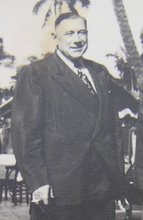 These models were made before construction of each rice conversion plant. Click on the image to enlarge.
These models were made before construction of each rice conversion plant. Click on the image to enlarge.
Sunday, April 1, 2007
Rice Conversion Plant Models for the Huzenlaub Process
 These models were made before construction of each rice conversion plant. Click on the image to enlarge.
These models were made before construction of each rice conversion plant. Click on the image to enlarge.
"Mars & Huzenlaub" - The First Rice Conversion Plant in the United States to utilize The Huzenlaub Process
An Uncle Ben's Converted Rice Box from the early years
Saturday, March 31, 2007
Erich Huzenlaub Finds Uranium in the Philippines
 C53 PMS and AMS
C53 PMS and AMSBy Henry Hartzenbusch
LOS BANOS, PHILIPPINES, APRIL 3 - AP - The rich, wild hill-country surrounding this hot springs resort may yield a big dollar earner for the Philippines--URANIUM.
A 65-year-old Texas chemist and his attractive wife stumbled onto the deposits while seeking to cure his kidney ailment. They could make a fortune.
Erich G. Huzenlaub of Houston, Texas has staked out 32 claims covering about 5,000 acres. The land stretches over thick, mountainous jungles, deep ravenes, muddy creeks, flat rice-paddies, sugar cane fields and grassland.
Los Banos, a town of 11,000, is about 35 air miles southeast of Manila.
Huzenlaub said in an interview: "We have found pitchblende which contains Uranium. That is definite. We are only not sure about its quantity. We will not know how large the deposits are until they are mined."
He said they are awaiting the arrival soon of three top U.S. geologists. The U.S. State Department requested permission from the Philippine Government for their entry to check the find.
President Elpidio Quirino announced the discovery in a news conference last Sunday. He said it had been made by a foreigner. He also disclosed U.S. government was interested.
Huzenlaub, a gray-haired heavy-set man of average height, came to the Philippines three years ago to establish a rice conversion plant. He said:
"We had indications that hot springs were radioactive when we came here last September. But it was only this year we had positive proof."
Huzenlaub said the geological structure of Los Banos reminded him of Carlsberg, Czechoslovakia, where Madame Curie found Radium.
"When we found the waters to be radioactive, we tried to trace its source," he said. "With the aid of Geiger counter, we found Radan gas at certain points above subterranean channels. The gas had apparently permeated the soil. Radan gas is emitted only by substances containing Radium and Uranium."
Huzenlaub estimated the depth from the earth surface to the channels at 2,500ft in the rugged slopes of Mount Makiling. Some of the underground streams are possibly four kilometers long, he said.
"Pitchblende is found along the walls of these channels," he said.
"We've had to cut down thick foliage with the aid of Filipino Bolo-Knives. We have been warned about the presence of communist Huk Dissidents, but we have not seen any," Huzenlaub said.
Huzenlaub said initial mining of the area would take place in the compound of the College of Agriculture. "This is where the Geiger counters registered rich deposits and where we busted one instrument," he said.
Huzenlaub did not say when operations would begin, "It will depend on the outcome of the visit of the geologists."
S1148ACS
Friday, March 30, 2007
Subscribe to:
Posts (Atom)



















